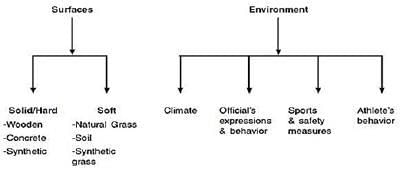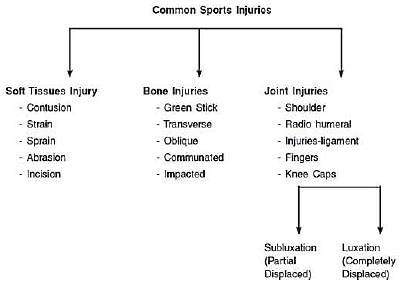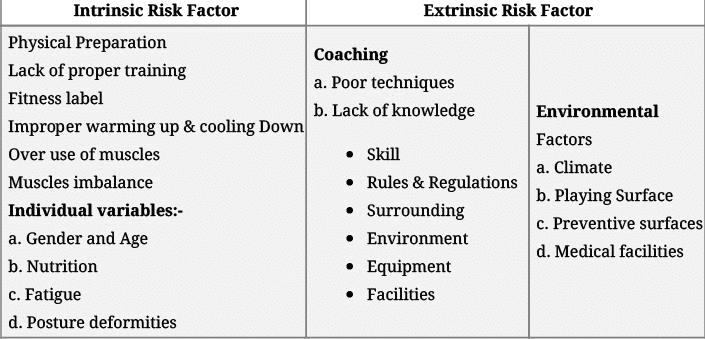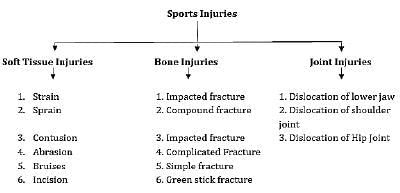Sports Medicine - Physical Education Revision Notes, Class 12 | Physical Education Class 12(XII) - Notes & Model Test Papers - Humanities/Arts PDF Download
Key Points:-
- Concept, Aims & Scope of Sports Medicine
- Sports Injuries: -Classifications, Causes & Preventive Measures
- First Aid- Aims & Objectives
- Management of Injuries
Sports medicine:-
Sports medicine is a branch of healthcare. It deals with the diagnosis, treatment and prevention of injuries related to participation in sports and/or exercise.
Scope of sports medicine:-
In the field of physical education and sports, the fields of various sub-disciplines of sports medicine are utilized. without the knowledge of the scope of sports medicine, it is difficult to carry a sportsperson performance at apex level. There are following the scope of sports medicine:
a) Sports and first aid
b) Human anatomy and physiology
c) Female and sports
d) Study of optimal load for different age groups
e) Scientific promotion of games and sports
f) Sports injury rehabilitation
g) Fitness for games and sports.
Aims of sports medicine:-
a) To provide information to athletes about injuries.
b) To provide knowledge about the causes of injuries.
c) To provide means or treatment for sports injuries and for the rehabilitation of injuries.
d) To provide knowledge about the preventive measures of sports injuries.
e. To aware the sports person & athlete about the different kinds of injury in respect of different games.
f. To concentrate on the causes of injury
Concept of Sports medicine:-
- Biomechanics related to sports
- Effect of attitude on endurance performance
- Psychological aspect of performance
- Nutrition & metabolism in relation to competition & performance
- Recommendations of FISM(the International Federation of Sports Medicine at world level)
- Cardio-respiratory function in relation to performance
- Exercise in Cardio-Vascular disease prevention & rehabilitation
Prevention of Sports Injuries:-
- Pre-participation of medical check-up
- Proper conditioning
- Avoid dehydration
- Protective Sports equipment & Gears
- Adequate & effectively maintained facilities
- Sports person’s psychological conditions & environment
- Adequate rehabilitation/Injury management
- Proper use of right techniques
- Balanced diet & adequate rest
- Use of proper skills
- Warming up & cooling down
Impact of surface on athletes:-
There are two types of surfaces used in any indoor or outdoor games. These are natural and artificial surfaces. Natural surfaces are the surfaces that are prepared through proper combination of natural elements like soil and grass. On the other hand, artificial surfaces are more like carpets which are made from artificial components like rubber, synthetic fiber etc. These surfaces impact performance of athletes differently. In many contact games like football, cricket, running and Kabaddi natural surfaces are preferred because they provide more familiarity, grip and void severe injuries. On the other hand, artificial surfaces provide more opportunities for practice because their use need not be stopped for maintenance. Also, with innovation in technology, artificial surfaces are becoming more user-friendly. Risks of injuries are reducing in artificial surfaces also nowadays.
3 Impact of Surfaces and Environment on Athletes
9.4 A. Sports Injury


Climatic conditions affect the performance
Environmental conditions, such as excessively high or low temperatures, have the potential to have a negative impact on an athlete‘s well-being. An athletes‘ ability to use a number of thermoregulation techniques helps in regulating body temperature.
Sports injuries are those which are common in the field of games and sports. During training, competition or practice, any player can be injured. Perhaps there will not be any player who has not been injured during his career. Strain is also a muscle injury. A strain is caused by twisting or pulling a muscle or tendon. A sudden strain is caused by a recent injury, lifting heavy objects or rods in wrong way and overstressing the muscles. Chronic strains are usually caused by moving the muscles and tendons in repetition. A sprain is a ligament injury. It may occur due to overstretching or tearing of ligaments. Many things can cause sprain. Falling, twisting, or getting hit can force a point out of its normal position. This can cause ligaments around the joints to tear. Generally, Sprain occurs at wrist and ankle joints.
Strain is also a muscle injury. A strain is caused by twisting or pulling a muscle or tendon. A sudden strain is caused by a recent injury, lifting heavy objects or rods in wrong way and overstressing the muscles. Chronic strains are usually caused by moving the muscles and tendons in repetition. A sprain is a ligament injury. It may occur due to overstretching or tearing of ligaments. Many things can cause sprain. Falling, twisting, or getting hit can force a point out of its normal position. This can cause ligaments around the joints to tear. Generally, Sprain occurs at wrist and ankle joints.
Prevention of sprain and strain:-
a) Conditioning should be performed during the preparatory period.
b) Sports equipment must be of good quality.
c) Play courts should be smooth and clean.
d) The scientific knowledge of games should be must for preventing strain.
e) Player should discontinue during the condition of fatigue.
f) Good officiating is essential for preventing such injury.
g) Players should be careful and alert during practice, training and competition.
Abrasion is a key injury generally occurs due to friction with certain equipment or a fall over the area where bone is very close to skin. It may be caused by a fall on a hard surface. As someone falls or slides on the ground, friction causes layers of the skin to rub off.
Bruises are not clearly seen as upper skin remains undamaged and inner blood vessels are damaged and collect beneath the skin. A fresh bruise may actually be reddish and after a few hours, it turns to blue or dark purple.
A laceration is a wound that is produced by tearing of soft body tissue.
A contusion is a muscle injury. A direct hit with or without any sports equipment can be the main cause of confusion. Confusion can also be due to minor accidents to the skin such as falling, bumping into something or being hit or kicked. In contusion blood vessels in muscles are broken and sometimes bleeding may occur in the muscles which may cause bruise. Stiffness and swelling are common features at the site of contusion.
Management:-
- Cold compression should be used immediately. Ice or cold water should not be used for more than 40 minutes persistently.
- The cold compression should be performed 5 to 6 times daily.
- If there is more swelling at the sight of contusion, anti-inflammatory medications should be given.
- If the swelling persists, consult a doctor immediately.
- For the purpose of rehabilitation, flexibility exercises should be performed.
Causes of sports injuries:- To effectively diagnose, rehabilitate and ultimately prevent subsequent injuries, a sports therapist
- Anatomical Factors: These are related to making up of the body. Leg length differences and cause injuries to ankle, hip and back.
- Age-related causes As the body ages, it changes. It is less able to produce force, recovers slower and soft tissues lose the ability to stretch. Therefore it is more prone to injury.
- Training related cause’s Excessive repetitive loading of the tissues is needed for successive adaptation. However, without suitable recovery, tissues never have the chance to adapt and can fail.
- Equipment selection factors These are related to the suitability of equipment. An instance is incorrect footwear, which will not protect the foot and ankle adequately. It also will not distribute forces effectively. Thus it increases the risk of injury. Impact and contact causes
- Impact or contact can be with objects, surfaces or other people. These injuries are common in contact sports like football, rugby, hockey etc. Also, they are common in more dangerous sports like motor racing, boxing and skiing.
Joint injuries & its types:-
A hard blow to a joint, a fall, a forceful throwing, lifting or hitting may cause dislocation. In fact, it is a dislocation of the surface of bones.
Types of dislocation:-
a) Dislocation of lower jaw: it occurs when the chin strikes to any other object. It may occur if mouth is opened excessively.
b) Dislocation of shoulder joint: dislocation of shoulder joint may occur due to a sudden jerk or a fall over a hard surface. The end of the humorous comes out from the socket. In fact when your shoulder dislocates, a strong force, such as a sudden blow to your shoulder. Pulls the bones in your shoulder out of place.
c) Dislocation of the hip joint: By putting maximum strength spontaneously may cause dislocation of the hip joint. The end of the femur is displaced from the socket.
d) Dislocation of the wrist: A sportsperson who participates in a sport or game in which he may fall, runs the risk of getting a dislocated wrist. A miscalculated landing can also cause a dislocated wrist. Infact, it generally occurs to the person who uses his hand to break his fall.
Preventions:-
a) Adequate warming-up should be performed prior to any activity.
b) Proper conditioning should be performed during preparatory period.
c) Stretching exercises should be included in warm-up
d) Players should be careful during training and competition.
e) Protective equipment should be used
f) Players should have good anticipation and concentration power
g) Always obey the rules and regulations.
h) Perform regular exercise around your shoulder, hip, and wrist joints etc.
i) Avoid falls or hits as far as possible.
Causes of fracture:-
Fracture usually occurs due to a high impact on the bone. It can be caused by overuse. The most common causes of fracture are:
a) In such sports event where there is a high impact.
b) Traumatic, forceful and unnatural movements.
c) Prolonged long-distance walking or running.
d) Sudden fall on hard surface.
e) Direct strike or hit with any solid sports equipment.
f) Osteoporosis.
Management of Fracture:-
a) Elevate the extremity and rest while bone heals itself.
b) Apply ice to the affected part for 24 to 48 hrs
c) If pain persists, give painkillers.
d) If there is any need of immobilization to the affected part, use a slint
e) After removal of swelling begin to put partial weight on the affected area.
f) Crutches or walking stick may be used in the beginning. After two weeks of start putting normal weight.
g) For 6 to 8 weeks, avoid the activity that caused a stress fracture. Then start doing the activity slowly.
|
12 videos|68 docs|31 tests
|
FAQs on Sports Medicine - Physical Education Revision Notes, Class 12 - Physical Education Class 12(XII) - Notes & Model Test Papers - Humanities/Arts
| 1. What is sports medicine? |  |
| 2. What is the role of sports medicine in physical education? |  |
| 3. What are the common sports injuries that sports medicine deals with? |  |
| 4. How can sports medicine help in the rehabilitation process? |  |
| 5. What qualifications do sports medicine professionals possess? |  |
|
12 videos|68 docs|31 tests
|

|
Explore Courses for Humanities/Arts exam
|

|

















